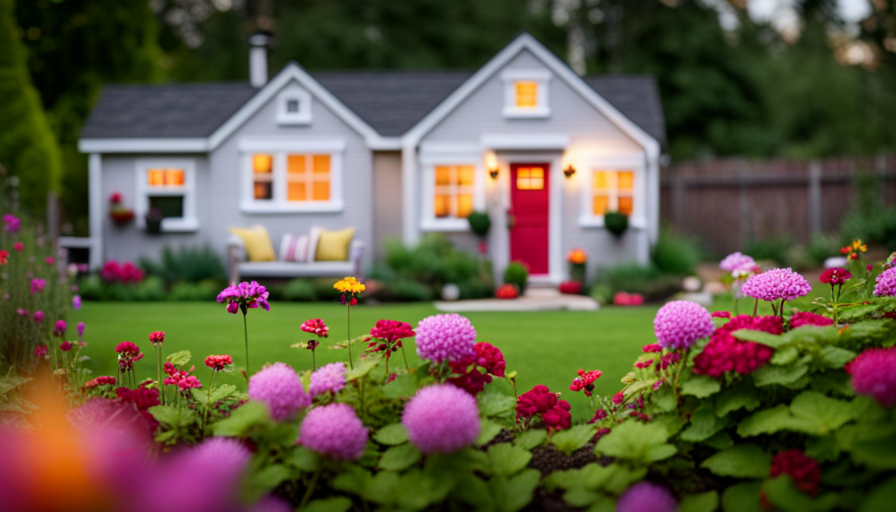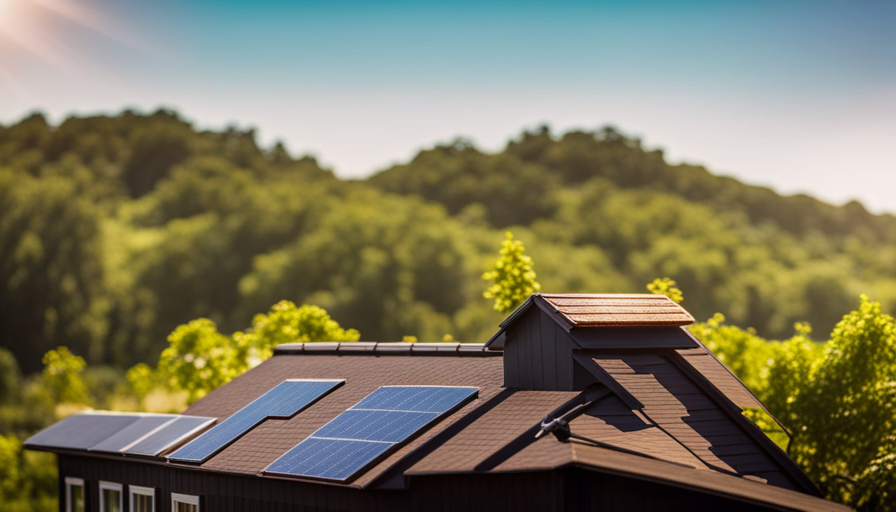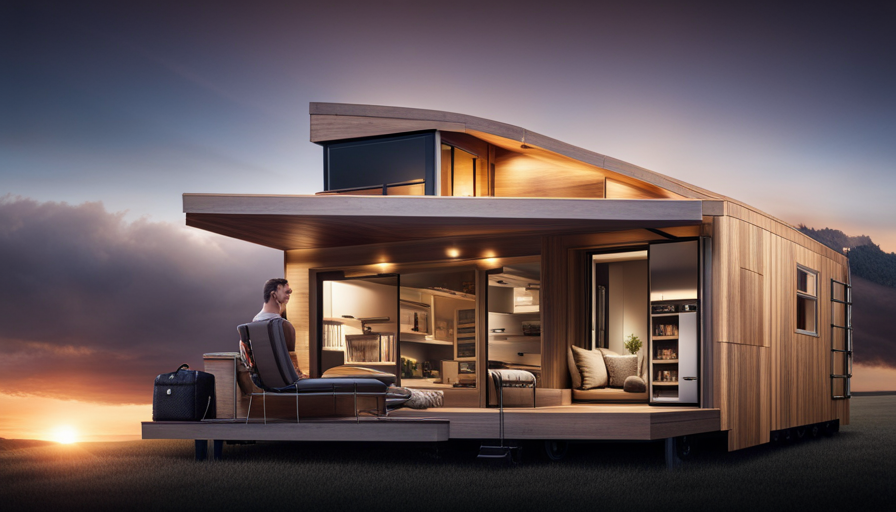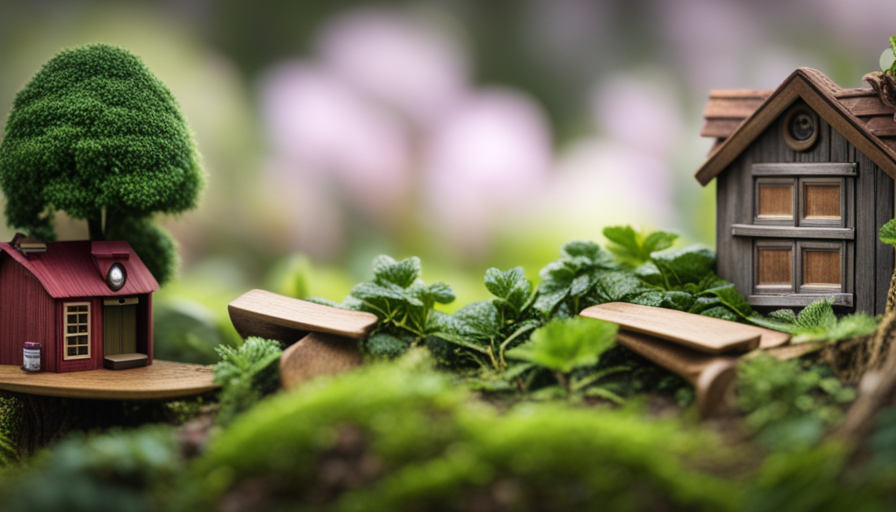Have you ever dreamt of living in a cozy, environmentally-friendly home that suits your minimalist lifestyle? Imagine a place where every inch is purposefully and efficiently utilized. A place that not only saves you money but also contributes to a more sustainable future. Welcome to the world of tiny houses.
In this article, I will guide you through the process of buying a tiny house and legalizing it as an Accessory Dwelling Unit (ADU). ADUs are becoming increasingly popular as a way to create additional living space on your property, whether it’s for family members, rental income, or simply to downsize.
But before you take the plunge, it’s important to understand the benefits of living in a tiny house, as well as the regulations and requirements for legalizing it as an ADU. From researching local zoning and building codes to consulting with local authorities, designing and building to code, and overcoming potential challenges, I’ll provide you with all the information you need to make your tiny house dream a reality.
So, let’s dive in and explore the world of tiny houses and ADUs together!
Key Takeaways
- Understanding local zoning and building codes is crucial for legalizing a tiny house as an ADU.
- Researching local financing options can provide grants, loans, or tax incentives for ADU construction.
- Connecting utilities and services in a tiny house requires professional contractors and brings convenience to daily life.
- Overcoming potential challenges, such as finding suitable locations and complying with neighborhood requirements, is necessary when legalizing a tiny house as an ADU.
Benefits of Living in a Tiny House
You’ll love the incredible benefits of living in a tiny house! Not only do these compact homes offer a unique and minimalist lifestyle, but they also provide significant cost savings and promote eco-friendly living.
One of the most attractive aspects of tiny house living is the affordability. With lower construction and maintenance costs, you can save a substantial amount of money. Additionally, tiny houses are designed to be energy-efficient, using less electricity and water, which further reduces expenses.
Living in a tiny house also allows you to minimize your carbon footprint. These compact homes require fewer resources to build and maintain, making them a greener housing option.
Understanding accessory dwelling units (ADUs) is the next step towards legalizing your tiny house as an ADU and unlocking even more benefits.
Understanding Accessory Dwelling Units (ADUs)
Discovering the ins and outs of ADUs can open up a world of possibilities for expanding your living space. Understanding zoning regulations is crucial when it comes to legalizing your tiny house as an ADU.
Each city has its own rules and restrictions regarding ADUs, so it’s important to familiarize yourself with the specific regulations in your area. This includes requirements for minimum lot size, setback distances, and parking.
Additionally, researching local financing options is essential. Some cities offer grants or low-interest loans specifically for ADU construction or conversion. Others may have programs that provide tax incentives or subsidies. By understanding these financing options, you can make informed decisions about how to fund your ADU project.
Transitioning into the subsequent section about researching local zoning and building codes, it’s vital to have a clear understanding of the regulations in order to ensure compliance and avoid any legal issues.
Researching Local Zoning and Building Codes
Exploring your area’s zoning and building codes is crucial to ensure compliance and avoid any legal complications when it comes to expanding your living space. Conducting thorough local zoning research and building code analysis will provide you with the necessary information to make informed decisions about your tiny house as an accessory dwelling unit (ADU). It is important to understand the specific regulations and requirements set by your local government, as they can vary significantly from one area to another. Some key factors to consider include setbacks, height restrictions, minimum lot size, and parking requirements. To visualize this process, refer to the table below:
| Zoning Regulations | Building Codes |
|---|---|
| Setbacks | Construction Type |
| Height Restrictions | Safety Standards |
| Minimum Lot Size | Electrical Wiring |
| Parking Requirements | Plumbing Systems |
By thoroughly researching and understanding your local zoning and building codes, you will be better equipped to navigate the process of legalizing your tiny house as an ADU. This knowledge will also facilitate your consultation with local authorities to ensure compliance and gain the necessary approvals.
Consultation with Local Authorities
When it comes to legalizing a tiny house as an accessory dwelling unit (ADU), it’s crucial to have a consultation with local authorities. Meeting with city planners allows for a thorough understanding of the specific zoning and building codes that need to be followed.
Additionally, obtaining the necessary permits is essential to ensure compliance with all regulations and to avoid any legal issues in the future.
Meeting with City Planners
Before meeting with city planners, make sure to thoroughly research the regulations and zoning requirements for tiny houses in your area, as this will demonstrate your commitment and preparedness during the discussion.
City planner consultation is crucial in understanding the specific guidelines and restrictions that apply to your situation. Familiarize yourself with the zoning regulations, setback requirements, and any other relevant ordinances that may affect the legality of your tiny house as an accessory dwelling unit (ADU).
Additionally, gather information on the application process and any necessary documentation required by the city planners. By doing so, you can address any concerns or questions they may have and present a well-informed case for legalizing your tiny house as an ADU.
Once you have a clear understanding of the regulations, you can move forward with obtaining necessary permits to make your tiny house compliant with local laws and regulations.
Obtaining Necessary Permits
Acquiring the requisite documentation and permits is essential for ensuring compliance with local regulations and moving forward with the construction of a legally approved tiny home. Navigating the legal requirements can be a complex process, but with careful planning and attention to detail, it’s achievable.
The first step is to research and identify the specific permits needed for your tiny house project. This may include building permits, zoning permits, and electrical permits, among others. Contacting the local building department or planning office is crucial to understand the requirements and procedures. They can provide guidance on the necessary paperwork, fees, and inspections.
It’s important to follow the guidelines precisely to avoid potential delays or fines. Once the necessary permits are obtained, you can proceed to the next phase of designing and building a tiny house to code, ensuring your project meets all the necessary safety and construction standards.
Designing and Building a Tiny House to Code
Designing and building a tiny house to code allows you to create a cozy and functional space that not only meets regulations but also fills your heart with excitement and pride.
When considering the design, it’s important to take into account the designing constraints imposed by your local building department. This may include limitations on the height, size, or placement of your tiny house.
Additionally, incorporating eco-friendly materials not only helps the environment but can also be cost-effective in the long run. Consider using sustainable materials such as reclaimed wood, recycled insulation, and energy-efficient appliances.
Paying attention to every detail during the construction process is crucial to ensure that your tiny house complies with all building codes.
By designing and building your tiny house to code, you can move on to the next step of connecting utilities and services seamlessly.
Connecting Utilities and Services
After designing and building a tiny house to code, the next step is connecting utilities and services. This involves finding contractors who can install the necessary connections for electricity, water, and sewage. It’s important to work with professionals who have experience in working with tiny houses and can ensure that the connections are made safely and efficiently.
To help you visualize the process, here is a table that highlights the emotional benefits of having utilities and services connected to your tiny house:
| Emotional Benefits | Connecting Utilities and Services |
|---|---|
| Convenience | Having all the necessary utilities readily available in your tiny house brings convenience to your daily life. |
| Comfort | A well-connected tiny house allows you to enjoy the comforts of home, such as running water and electricity. |
| Independence | Being able to connect to utilities and services gives you the freedom to live independently, without relying on others. |
| Peace of Mind | Knowing that your tiny house is properly connected to utilities and services provides peace of mind and a sense of security. |
With utilities and services connected, the next section will focus on ensuring safety and security in your tiny house.
Ensuring Safety and Security
Once you’ve got all your utilities and services connected, it’s time to ensure the safety and security of your cozy little haven. Here are some important steps to take in order to guarantee the well-being of your tiny house as you go through the process of legalizing it as an ADU:
- Install a reliable security system to protect your tiny house from potential intruders.
- Consider adding fire alarms and carbon monoxide detectors to ensure the safety of you and your loved ones.
- Implement proper lighting both inside and outside your tiny house to prevent accidents and deter any unwanted visitors.
- Secure your windows and doors with sturdy locks and reinforce them if necessary.
Ensuring the safety and security of your tiny house is crucial before moving forward with the process of applying for ADU legalization. By taking these precautions, you can have peace of mind knowing that your cozy abode is safe and protected.
Now, let’s delve into the next section about applying for ADU legalization.
Applying for ADU Legalization
When it comes to making your tiny haven officially recognized as an ADU, getting the process of applying for legalization can be an exciting and rewarding journey. The applying process for ADU legalization involves several steps and documentation requirements. To help you navigate through this process smoothly, here is a breakdown of the key steps and documents you will need:
| Step | Description |
|---|---|
| 1 | Research local regulations and requirements for ADU legalization. |
| 2 | Prepare architectural plans and site layout for your tiny house. |
| 3 | Submit a completed application form along with the necessary documents, such as proof of ownership and utility connections. |
| 4 | Pay any required fees and wait for the application to be reviewed. |
| 5 | Schedule an inspection to ensure compliance with safety and building codes. |
By following these steps and providing the required documentation, you can increase your chances of successfully legalizing your tiny house as an ADU. However, the process may still have potential challenges that you need to overcome, which will be discussed in the next section.
Overcoming Potential Challenges
Navigating the application process for ADU legalization can present some obstacles, but fear not, there are ways to overcome these challenges and turn your tiny haven into an officially recognized home.
One of the potential obstacles you may encounter is finding suitable locations for your tiny house. Depending on local regulations, you might face restrictions on where ADUs are allowed. Researching zoning laws and consulting with local authorities can help you identify areas where you can legally place your tiny house.
Additionally, some neighborhoods or communities may have specific requirements or design guidelines for ADUs, so it’s important to familiarize yourself with these before starting the application process.
By doing thorough research and being proactive in addressing any potential obstacles, you can increase your chances of successfully legalizing your tiny house as an ADU. This will allow you to enjoy the benefits of an affordable and sustainable home without compromising on comfort or style.
Enjoying the Benefits of an Affordable and Sustainable Home
Embracing the perks of an affordable and eco-friendly dwelling is like discovering a hidden treasure trove of savings and sustainability. When you buy a tiny house and legalize it as an ADU, you open the door to a world of benefits.
One of the most significant advantages is the affordability factor. Tiny houses are a cost-effective housing solution, offering a lower mortgage or rental payment compared to traditional homes. This financial freedom allows for more flexibility and a reduced financial burden.
Additionally, tiny houses are designed with environmental sustainability in mind. They often utilize eco-friendly materials, energy-efficient appliances, and renewable energy sources. By living in a tiny house, you actively contribute to reducing your carbon footprint and promoting a greener lifestyle. It’s a win-win situation, where you can enjoy the comforts of home while making a positive impact on the environment.
Frequently Asked Questions
Can I legally live in a tiny house on any piece of land?
I’m not an expert, but from my understanding, living in a tiny house on any piece of land may not be legal. Zoning regulations vary, and you should research local laws regarding tiny house zoning and the process of legalizing tiny homes.
How long does the process of legalizing an ADU typically take?
The average timeline for legalizing an ADU can vary depending on local regulations and challenges. Common challenges include obtaining permits, meeting building codes, and navigating zoning restrictions.
Are there any restrictions on the size or height of a tiny house that can be legalized as an ADU?
There are size and height restrictions when legalizing a tiny house as an ADU. The specific limitations may vary depending on local regulations, but they typically exist to ensure the structure meets safety and zoning requirements.
What are the potential penalties or consequences if I live in a tiny house without legalizing it as an ADU?
Living in a tiny house without legalizing it as an ADU can result in potential penalties such as fines and eviction. It may also impact property value and pose challenges of living off-grid.
Are there any financial assistance programs available to help with the costs of legalizing a tiny house as an ADU?
Financial assistance programs may be available to help with the costs of legalizing a tiny house as an ADU. Eligibility requirements and potential funding sources vary, and the application process typically involves providing documentation and demonstrating financial need.
Conclusion
In conclusion, opting for a tiny house and legalizing it as an ADU offers a plethora of benefits. Living in a compact yet functional space not only promotes a minimalist lifestyle but also helps reduce carbon footprint.
By adhering to local zoning and building codes, consulting with authorities, and designing a safe and secure structure, one can successfully navigate the process of legalizing their tiny house. Overcoming potential challenges along the way, homeowners can ultimately enjoy the advantages of an affordable and sustainable home.
The coincidence of affordability and sustainability makes this option all the more appealing for those seeking a unique and eco-friendly living experience.
I’m Theodore, and I love tiny houses. In fact, I’m the author of Tiny House 43, a book about tiny houses that are also tree houses. I think they’re magical places where imaginations can run wild and adventures are just waiting to happen.
While tree houses are often associated with childhood, they can be the perfect adult retreat. They offer a cozy space to relax and unwind, surrounded by nature. And since they’re typically built on stilts or raised platforms, they offer stunning views that traditional homes simply can’t match.
If you’re looking for a unique and romantic getaway, a tree house tiny house might just be the perfect option.










